|
December 2014 - March 2015 |
| |
|
|
 |
|
 |
| |
Publisher: Chairman Gong-Ru Lin Editors: Professor
Chao-Hsin Wu, Ms. Hsiao-wen Lin April 30, 2015 |
| |
|
 |
|
Congratulations to GIPO professor Ching-Fuh Lin and master student Pin-Chun Shen for winning the “2014 distinguished contribution in technology transfer” prize from the Ministry of Science and Technology.
|
Inventor |
The invention
|
|
Professor Ching-Fuh Lin, and master student Pin-Chun Shen |
Method for fabricating metal-ion-doped zinc sulfide and method for generating a warm white light by using the metal-ion-doped zinc sulfide |
Congratulations to the following master/doctoral students for winning, under instruction of each of the following advisers, the OPTIC 2014 Student Paper Award:
|
Student’s name |
Award
|
Adviser |
|
Cheng-Ting Tsai |
OPTIC 2014 Student Paper Award, doctoral student |
Gong-Ru Lin |
|
Tzu-Fang Tseng |
OPTIC 2014 Student Paper Award, doctoral student |
Chi-Kuang Sun |
|
Shih-Yu Tu |
OPTIC 2014 Student Paper Award, doctoral student |
Hoang-Yan Lin |
|
Meng-Yu Weng |
OPTIC 2014 Student Paper Award,
master student |
Chi-Kuang Sun |
|
Szu-Yu Lee |
OPTIC 2014 Student Paper Award,
master student |
Chi-Kuang Sun |
|
Chung-Yu Lin |
OPTIC 2014 Student Paper Award,
master student |
Gong-Ru Lin |
|
Chien-Ting Liu |
OPTIC 2014 Student Paper Award,
master
student |
Ching-Fuh Lin |
Congratulations to GIPO professors Lon A. Wang, Lung-Han Peng, Jui-Che Tsai and Yuh-Renn Wu, members of EECS slow-pitch softball team, after three long battles, won the championship of the “slow-pitch softball tournament of the teaching and administrative staff of NTU EECS, College of Law and College of Engineering”, the 1st championship since the establishment of the EECS team!
|
|
 |
|
 |
|
| |
|
 |
|
November “GIPO Colloquium” Highlights
(Compiled by Li-Chi Yao) |
|
|
4:30 pm, Nov. 14 (Fri.), 2014 |
|
Speaker: |
Professor Donghyun Kim (School of Electrical Engineering, Yonsei University, Seoul, Korea) |
|
Topic: |
Surface-Enhanced Nanoplasmonics: Biosensor and Imaging Applications |
| |
Professor Donghyun Kim visited GIPO on Nov. 14 (Fri.) and delivered a speech concerning “Surface-Enhanced Nanoplasmonics: Biosensor and Imaging Applications” at lecture theater 101, Barry Lam Hall. His speech was fascinating, and the professor interacted well with students. GIPO teachers and students attended the speech with enthusiasm and learned a great deal. |
| |
|
 |
|
Professor Donghyun Kim (left), and Professor Chi-Kuang Sun, the host of the speech |
|
|
|
4:30 pm, Nov. 21 (Fri.), 2014 |
|
Speaker: |
Dr. Yen-Yin Lin (research fellow, Institute of Photonics Technologies, National Tsing Hua University) |
|
Topic: |
Observing fruit fly’s neural networks, using photonics methods |
| |
Dr. Yen-Yin Lin visited GIPO on Nov. 21 (Fri.) and delivered a speech concerning “Observing fruit fly’s neural networks, using photonics methods” at lecture theater 101, Barry Lam Hall. His speech was fascinating and informative, and the professor interacted well with students. GIPO teachers and students attended the speech with enthusiasm and benefitted a great deal from the experience. |
|
|
|
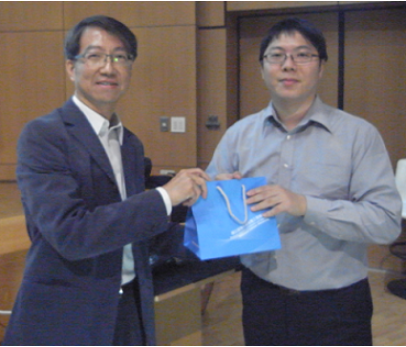 |
|
Dr. Yen-Yin Lin (right), and Professor Chi-Kuang Sun, the host of the speech |
|
|
|
4:30 pm, Nov. 28 (Fri.), 2014 |
|
Speaker: |
Dr. Chih-Wei Chu (Research Center for Applied Sciences, Academia Sinica) |
|
Topic: |
Conducting polymer for energy-related applications |
| |
Dr. Chih-Wei Chu visited GIPO on
Nov. 28 (Fri.) and delivered the
speech “Conducting polymer for energy-related applications” at lecture theater 101, Barry Lam Hall. His speech was interesting and informative, and the speaker interacted well with students. GIPO teachers and students learned a great deal from the experience.
|
|
December “GIPO Colloquium” Highlights
(Compiled by Li-Chi Yao) |
|
|
4:30 pm, Dec. 5 (Fri.), 2014 |
|
Speaker: |
Professor J. E. Bowers (University of California, Santa Barbara, USA) |
|
Topic: |
Heterogeneous Integration for Silicon Photonic Integrated Circuits |
| |
Professor J. E. Bowers visited GIPO on Dec. 5 (Fri.) and delivered a speech concerning “Heterogeneous Integration for Silicon Photonic Integrated Circuits” at lecture theater 101, Barry Lam Hall. His speech was fascinating and informative, and the speaker interacted well with students. GIPO teachers and students attended the event with enthusiasm and gained a great deal from the experience.
|
|
|
4:30 pm, Dec. 12 (Fri.), 2014 |
|
Speaker: |
Dr. Chia-Yen Huang (University of California, Santa Barbara, USA) |
|
Topic: |
Development of InGaN-based Nonpolar and Semipolar Green Laser Diode (LD) in UCSB |
| |
Dr. Chia-Yen Huang visited GIPO on Dec. 12 (Fri.) and delivered a speech concerning “Development of InGaN-based Nonpolar and Semipolar Green Laser Diode (LD) in UCSB” at lecture theater 101, Barry Lam Hall. His speech was interesting and informative, and the professor interacted well with students. GIPO teachers and students had fervently taken part in this event and gained a lot from it.
|
|
|
4:00 pm, Dec. 19 (Fri.), 2014 |
|
Speaker: |
Professor Zhe-Chuan Feng (GIPO, NTU) |
|
Topic: |
Retirement speech: The conclusive report of my 11 years’ study in photonics |
| |
Professor Zhe-Chuan Feng, who retired in January, 2015, delivered his retirement speech on Dec. 19 (Fri.) at lecture theater 101, Barry Lam Hall. We invited Professor Feng to deliver a speech during GIPO’s designated subject course out of appreciation for his constant contribution to GIPO, and to allow students and teachers to learn from his abundant experiences and knowledge. The topic of his speech was “The conclusive report of my 11 years’ study in photonics”. Professor Feng’s speech was wonderful and GIPO teachers and students took part in the event with enthusiasm. Everyone learned a great deal. |
| |
|
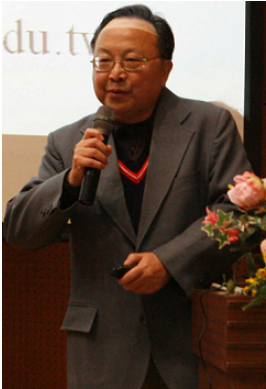 |
|
The speaker, Professor Zhe-Chuan Feng |
|
|
|
4:30 pm, Dec. 26 (Fri.), 2014 |
|
Speaker: |
Professor Hiro-o Hamaguchi (Department of Applied Chemistry, National Chiao Tung University) |
|
Topic: |
Raman microspectroscopy goes beyond “imaging” |
| |
Professor Hiro-o Hamaguchi visited GIPO on Dec. 26 (Fri.) and delivered a speech concerning “Raman microspectroscopy goes beyond imaging” at lecture theater 101, Barry Lam Hall. His speech was fascinating and informative, and the professor interacted well with students. GIPO teachers and students participated with enthusiasm and learned a great deal. |
| |
|
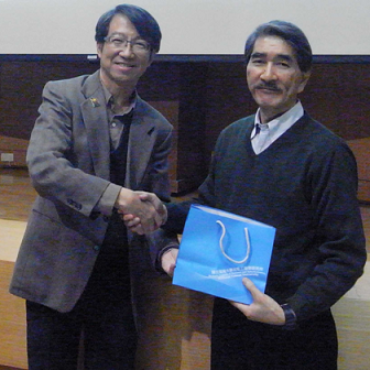 |
|
Professor Hiro-o Hamaguchi (right), and Professor Chi-Kuang Sun, the host of the speech |
|
|
December “Photonics Forum” Highlights
(Compiled by Li-Chi Yao) |
|
|
4:30 pm, Dec. 19 (Fri.), 2014 |
|
Speaker: |
Professor Hiroshi Amano (the 2014 Nobel physics prize winner; Department of Electrical Engineering and Computer Science, Graduate School of Engineering, Nagoya University) |
|
Topic: |
History of the development of blue and UV LEDs and their impact on the future human society |
| |
GIPO invited Professor Hiroshi
Amano, the 2014 Nobel physics prize
winner, to deliver a speech
concerning “History of the development of blue and UV LEDs and their impact on the future human society” at lecture theater 101, Barry Lam Hall on Dec. 19 (Fri.). His speech was interesting and informative. GIPO teachers and students participated with enthusiasm and gained a great deal from the experience. |
| |
|
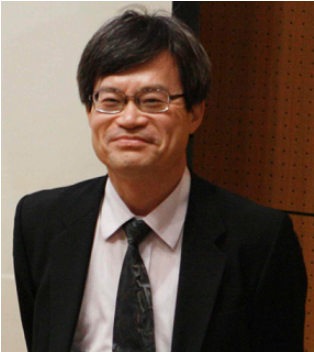 |
|
The speaker, Professor Hiroshi Amano |
|
|
January “Photonics Forum” Highlights
(Compiled by Li-Chi Yao) |
|
|
4:30 pm, Jan. 9 (Fri.), 2015 |
|
Speaker: |
Dr. Peter Shih (Chairman, Photonics Industry & Technology Development Association (PIDA)) |
|
Topic: |
The retrospect and prospect of the development of Taiwan’s photonics industry in 30 years |
| |
Dr. Peter Shih visited GIPO for the
International Year of Light and
Light-based Technologies (IYL 2015)
on Jan. 9, 2015. Often called “the father of Taiwan’s photonics”, Dr. Shih delivered a speech concerning “The retrospect and prospect of the development of Taiwan’s photonics industry in 30 years” at lecture theater 101, Barry Lam Hall. His speech was fascinating and Dr. Shih interacted well with his audience. GIPO teachers and students took part in this event with enthusiasm and gained a lot from the experience. |
| |
|
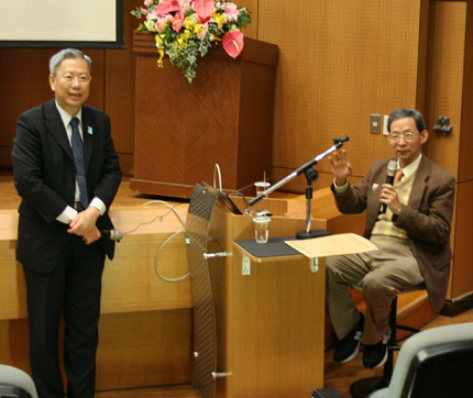 |
|
Dr. Peter Shih (right), and Professor Din-Ping Tsai, the host of this speech |
|
|
~ 2015 International Year of Light Talks in Taiwan Opening Ceremony
~
(Time: Jan. 9, 2015; Location: Lecture theater 101, Barry Lam Hall, NTU)
2015 International Year of Light Talks in Taiwan Opening Ceremony was held at the GIPO Photonics Forum on Jan. 9, 2015. In 2013, officials at the 68th meeting of the United Nations had announced that the year 2015 would be the International Year of Light and Light-based Technologies (IYL 2015). University of Applied Sciences Offenburg, Germany, had, afterwards, established an IYL 2015 web site and started this global campaign. On IYL 2015’s logo, the beaming light stands for the origin of constant and sustainable life, and the colorful banner stands for major achievements of human civilization, such as art, culture, science, education, tolerance and internationalism. In response to this event, Taiwan has also organized a number of camps, academic activities, and designated GIPO to hold the International Year of Light Talks in Taiwan Opening Ceremony. We invited many academic VIPs and NTU staff to attend this ceremony, including Professor Pan-Chyr Yang (NTU president), Professor Din-Ping Tsai (president of Taiwan Photonics Society), Professor Cheng-Chung Lee (honorary president of Taiwan Photonics Society), Dr. Peter Shih (chairman of Photonics Industry & Technology Development Association), Professor Sy-Yen Kuo (dean of EECS, NTU), Professor Wanjiun Liao (chair of Department of Electrical Engineering, NTU), Professor Gong-Ru Lin (chairman of GIPO, NTU) and Professor Jian-Jang Huang (secretary general of Taiwan Photonics Society).
|
~ 2014 GIPO year-end party ~
(Time: Dec. 29, 2014; Location: 3F courtyard, Ming-Da Hall, EECS, NTU)
Composed by
Yu-Hsiang Su,
the president of GIPO Student Association
With reoccurring food security issues and the student activism movement, the year 2014 seemed full of turmoil. However, there were even more happy moments that meant a great deal to us. With the year-end party, we are happy to have the opportunity to dine, chat and share our joy with classmates. This year, besides the usual delicacies and invited performers, we are lucky to have several student groups perform for us as well. These groups attracted frequent bursts of applause and made everyone cheer with excitement.
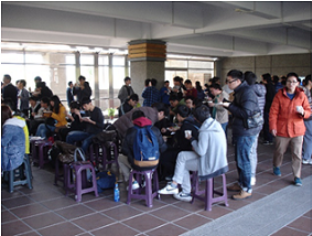 |
 |
|
Students enjoying food
and watching a show |
Students had preregistered for this Monday party with enthusiasm, and, on the day, the place gradually warmed up after participants signed in and chatted amidst the gently flowing music of the electronic organ. We had the honor of having GIPO chairman, Gong-Ru Lin, make the opening address. Chairman Lin have been kind enough to support our plan of gifting students with the book –
The Journey of Electricity, an Exploration of How Human Managed to Take Hold of Electrons – and inscribe his blessing in the book, which was greatly appreciated. Next, the handsome vice-president of GIPO Student Association, Peng-Jui Wang, took over hosting duties for the party, which proceeded smoothly due to his excellent management skills and eloquence.
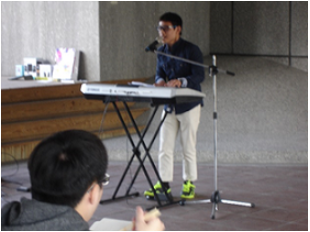 |
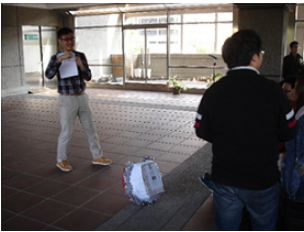 |
|
Students of the
Electronic Organ Club performing |
The host, Peng-Jui Wang, preparing the 1st
round lottery |
After students selected their food and settled down in their seats, the entertainment proceeded on stage. Two students from NTU fire-dance club performed a splendid color-ball show. Although the show did not include fire, due to safety concerns, the dancers’ coordinated movements and beautiful throwing technique was still very admirable.
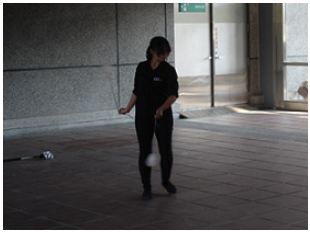 |
 |
|
The Fire-dance Club’s
performance |
Next was the most anticipated drawing for prizes, with students very excited to draw for the 12 movie-tickets. The lucky winners of these prizes will likely enjoy a wonderful movie-going experience. Meanwhile, we also gave out prizes of practical selfie clips, mobile phone photo lenses, and meal vouchers for the delicious Tasty Steak House.
After the lottery, Yen-Chang Chen, Shuo Hwai and Meng-Jung Wu, the 1st of the student performing groups, played and sang a touching melody, which attracted loud applause and encore calls from the audience and familiar friends.
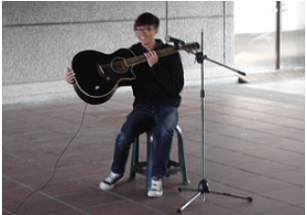 |
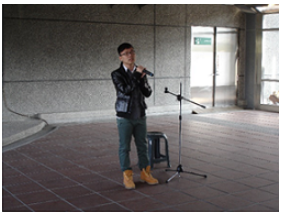 |
|
The student performer |
The student
performer |
As soon as the cheers for the first student performers died down, Yan-Lin Chen quickly captured the attention of the audience with his splendid magic show. At first, he amazed us by producing a drink out of thin air. Then he invited a student on stage to interact with him, which made the show more interesting and enjoyable.
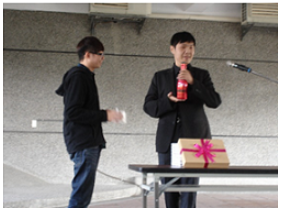 |
 |
|
The magician produces
a drink out of nothing. |
The magician
invites a student on stage to
interact with him. |
The party gave us an opportunity to realize that there are lots of talented singers and musicians in GIPO. When Ling-Yi Kuo, Hsiang-Cheng Wang and Chia-Sheng Wang sing “the Sun” (originally performed by Cheer Chen), their steady voice and guitar, accompanied by Cajon drum, created pleasant and touching melody. The singing of “I Won’t Give Up”, by Ting-An Ku and Xue-Qian You, was also highly appreciated. Finally, after those performances, the party neared its end with those lovely voices lingering in everyone’s ears.
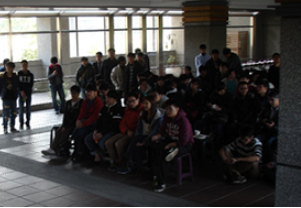 |
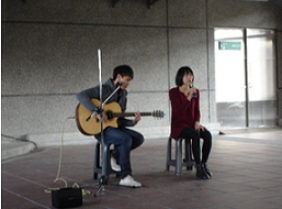 |
|
Students are immersed in the sweet melodies. |
The student
performers |
Last of all came the most highly-anticipated big lottery at the end of the party. The host first thanked those who made this party possible, then drew lots to determine the prize winners. The prizes include Kitchen 12’s afternoon tea buffet vouchers, Logitech’s computer speakers, backpacks, Polaroid cameras and an iPad. Finally, in the excitement and tension, the lucky winner of the biggest prize, the iPad, was chosen. Although we are unable to provide everyone with a prize, there will still be chances for everyone next year. We would also like to thank every student who came to the party, and wish you every success for your hard work next year.
This party could not have been successful without all the help from others. Therefore, we would like to thank GIPO teachers, especially Chairman Gong-Ru Lin, who has addressed the party and inscribed the gift books. Also, thank you to Professor Chao-Hsin Wu for helping us in drawing lots. The staff
members of the GIPO office were also of great help in preparing the party; thanks to Ms. Li-Chi Yao for her advice in arranging party details and help in processing necessary papers. We would also like to thank Mr. Wu and Ms. Wang of Barry Lam Hall and Ming-Da Hall for providing the space and equipment.
We would also like to thank our student association friends for their help in preparing the party. The most reliable Peng-Jui Wang, vice-president of GIPO Student Association, was a mastermind behind the party planning, and worked hard in purchasing prizes, coordinating performers and planning the whole event. In addition to performing, Yan-Lin Chen also helped in structuring the activities. Ting-Hao Chen, my senior classmate, provided many experienced suggestions and lots of manpower support. Yuan-Ju Yang enthusiastically helped in designing delicate posters; she also worked together with Ling-Yi Kuo in making a “precious ball” for drawing lots. Yuan-Ju Yang and Ling-Yi Kuo also worked together with Chia-Ying Tseng in helping with checking in at the party and sending out lottery tickets, which enabled attendants to be seated promptly. Cheng-You Yao provided many great prize ideas and spent time and effort purchasing them; he also worked together with Wen-Cheng Shih and Yi-Hua Liang in delivering equipment. Wei-Chieh Lin and Chia-Sheng Wang helped in cleaning and packing until the last moment. Yi-Jiun Chen and Yan-Shuo Chang, senior classmates, who are very involved in GIPO affairs, kindly helped in handling details. We would like to thank again these and all other people who have made the party successful, and wish you a most wonderful new year, farewell!
|
 |
|
 |
|
| |
|
 |
|
~ 2014 3D Interaction &
Image
Display Forum
~
(Time: Dec. 22, 2014;
Location:
Barry Lam Hall, NTU)
Recently, 3D image and interaction techniques have gradually become popularized and fitted in with users’ lives. In order to increase the
communication of academic and industry
researchers, and develop higher-valued 3D interaction applications, GIPO and 3D Interaction & Display Association (3DIDA) organized the “2014 3D Interaction &
Image Display Forum” at room 201, Barry Lam Hall, NTU, on December 22, 2014. This forum was also co-organized by National Yunlin University of Science and Technology and the Institute of Electronics Information and Communication Engineers (IEICE).
|
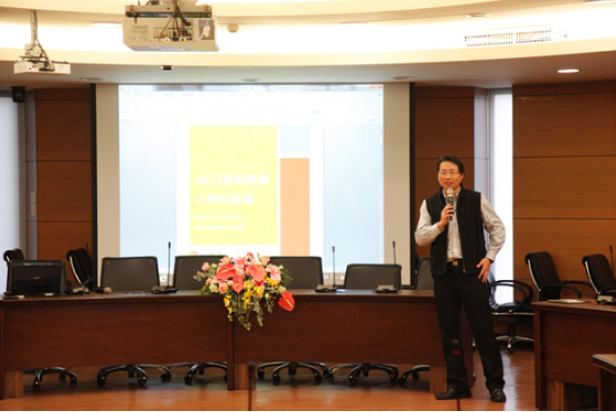 |
|
Professor Yi-Pai Huang, president of 3DIDA, addressing the forum in the opening ceremony |
At the invitation of Academic Promotion Group of 3DIDA and Professor Hoang-Yan Lin, six
specialists of 3D image and interaction technique came to the forum to share with us their advanced techniques and
their future applications, which would include software and hardware, theories and applications. Its agenda was as follows:
|
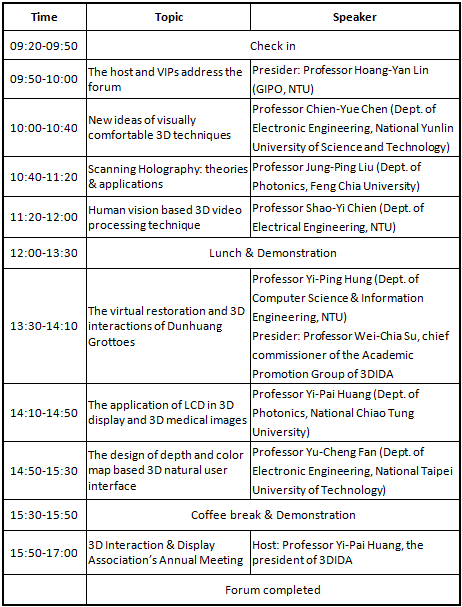 |
|
The agenda of the forum |
|
|
|
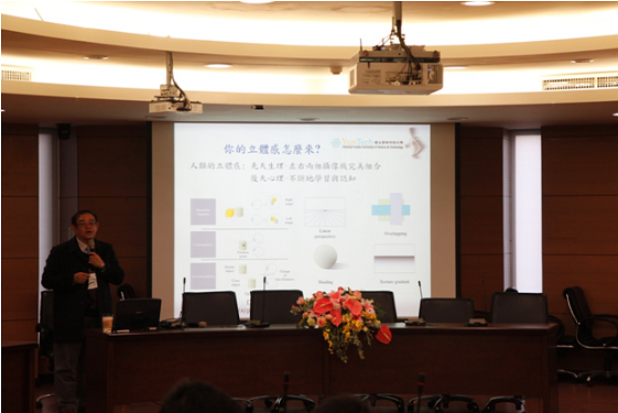 |
|
Professor Chien-Yue Chen delivering a speech |
There was also a exhibition to invite 3DIDA’s
company members, including NTU Professor
Yi-Ping Hung’s laboratory, Neo
3DHiVision Co., Ltd., General Interface
Solution Ltd. and GRISM Tech. Co., Ltd.,
to demonstrate their 3D interaction and
display techniques in the courtyard of
the conference room, i.e. room 201,
Barry Lam Hall. We hope this forum will
produce consonance, promote cooperation
and benefit all among academics and
industries.
|
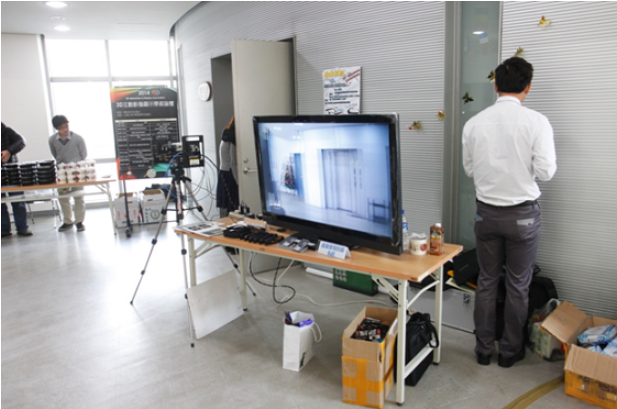 |
|
GRISM Tech. Co., Ltd.’s demonstration |
After the forum, thesis awards were presented to several master and doctoral students. Three doctoral thesis
award winners made brief reports of their theses to the conference, and the master thesis
award winners posted their theses at the
courtyard. After taking a group photo of all the attendants, the all-day-long forum came to a successful close.
|
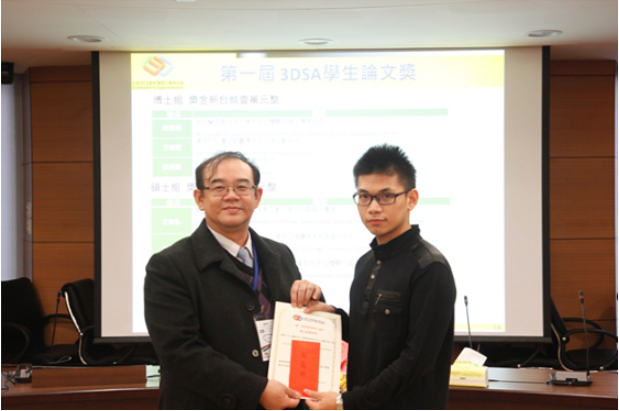 |
|
The awarding of master and doctoral thesis prizes |
|
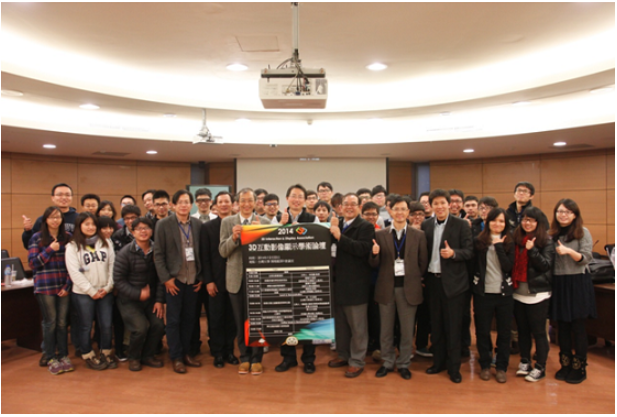 |
|
A group photo of all attendants |
|
|
 |
|
 |
|
| |
|
 |
Virtual Channels for Flowing Magnetic Beads
Professor Jui-che Tsai
Graduate Institute of Photonics and
Optoelectronics, National Taiwan University
We have demonstrated the feasibility of a novel microfluidic system with virtual channels formed by ‘walls’ of magnetic fields, including collecting channels, transporting channels and function channels. The channels are defined by the nickel patterns. With its own ferromagnetism, nickel can be magnetized using an external magnetic field; the nickel structures then generate magnetic fields that can either guide or trap magnetic beads. A glass substrate is sandwiched between the liquid containing magnetic beads and the chip with nickel structures, preventing the liquid from directly contacting the nickel (Fig. 1). Collecting channels with different shapes are compared (Fig. 2). Moreover, we demonstrate I-, S- and Y-shaped transporting channels can steer magnetic beads smoothly. Also, a switchable trapping channel implemented with a bistable mechanism can perform the passing and blocking of a magnetic bead.
|
 |
|
Figure 1 |
|
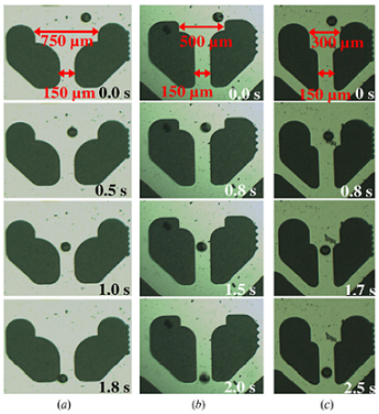 |
|
Figure 2 |
© 2014 IOP Publishing Ltd
S. H. Tang, H. W. Chiang, M. C. Hsieh,
Y. D. Chang, P. F. Yeh, W. Y. Shieh, and J. C. Tsai, “An approach to implement
virtual channels for flowing magnetic beads,”
Journal of Micromechanics and Microengineering,
vol. 24, no. 7, 075016, July 2014.
Gate-Bias Stress Stability of
P-Type SnO Thin-Film Transistors Fabricated by
RF-Sputtering
Professor I-Chun Cheng
Graduate Institute of Photonics and
Optoelectronics, National Taiwan University
Inverted-staggered bottom-gate rf-sputtered p-type SnO thin-film transistors (TFTs) with an atomic layer deposited HfO2 gate dielectric were demonstrated on glass substrates, and the gate-bias stress stability of these TFTs was investigated. The SnO TFT exhibits a threshold voltage of 2.5 V, a field-effect hole mobility of 0.24 cm2V−1s−1, a sub-threshold swing of 2 V/decade, and an ON/OFF current ratio of 103. Under gate-bias stress, the transfer characteristics shift with the same polarity as the stress voltage, whereas the sub-threshold swing and field-effect mobility remain almost unaltered. The threshold voltage shifts under various gate-bias stress voltages are well fitted by the stretch-exponential equation. The characteristic trapping time of carriers increases from 1.2 × 104 s to 6.8 × 105 s when the gate-bias stress voltage changes from −12.5 V to −5 V and increases from 1.3 × 103 s to 4.7 × 104 s when the gate-bias stress voltage decreases from 12.5 V to 5 V. This indicates that the dominant mechanism of the threshold voltage shift is the charge trapping at the interface between the active layer and the gate dielectric or at the gate dielectric near the interface. Larger amounts of threshold voltage shifts observed in the positive gate-bias stress may be caused by the bias-induced adsorption of oxygen on the unpassivated backchannel surface in addition to charge trapping.
|
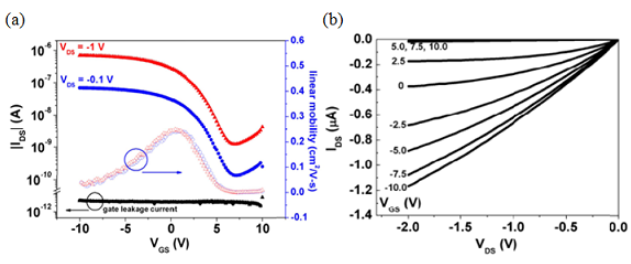 |
|
Figure 1 (a) Transfer and (b) output characteristics of inverted-staggered bottom-gate SnO TFT. |
|
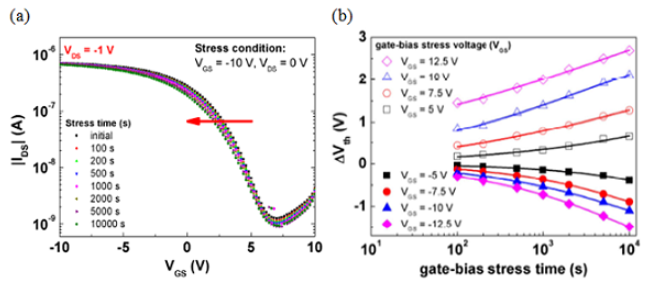 |
|
Figure 2 (a) Transfer characteristics of SnO TFTs at various gate-bias stress times. (b) Threshold voltage shift ( Vth) as a function of gate-bias stress time under various gate-bias stress voltages at both polarities. Vth) as a function of gate-bias stress time under various gate-bias stress voltages at both polarities. |
Ref: I-Chung Chiu and I-Chun Cheng, “Gate-bias
stress stability of p-type SnO thin-film transistors fabricated by
rf-sputtering,” IEEE Electron Device Letters, vol. 35, pp. 90-92, 2014
3D Analysis of the influence of random indium alloy fluctuations in InGaN quantum wells on the device behavior
Professor Yuh-Renn Wu
Graduate Institute of Photonics and
Optoelectronics, National Taiwan University
In this research project, our group worked with Prof. James S. Speck in SSLEEC in UCSB. We work on developing 3D analytical simulation tool to be capable to analyze the carrier transport and recombination behavior in random alloy InGaN quantum well. With the experimental result of indium distribution of InGaN quantum well obtained by Atom Probe tomography provided from UCSB. We analyze the influence of the intrinsic random indium fluctuation in the InGaN quantum wells on the carrier transport, efficiency droop, and emission spectrum in GaN-based light emitting diodes (LEDs). Both real and randomly generated indium fluctuations were used in 3D simulations and compared to quantum wells with a uniform indium distribution. We found that without further hypothesis the simulations of electrical and optical properties in LEDs such as carrier transport, radiative and Auger recombination, and efficiency droop are greatly improved by considering natural nanoscale
indium fluctuations. The detail result is published in JAP 116, 113104 (2014).
|
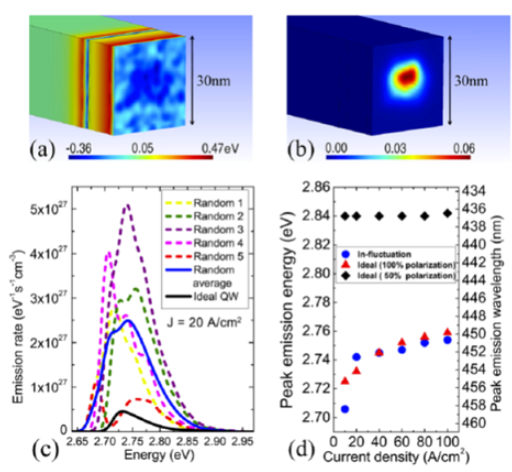 |
|
Fig. 1. (a) The calculated QW conduction band potential map with indium fluctuations at a forward bias of 2.94V. The dark blue color shows the deepest potential (higher indium composition) in the QW. (b) One of the electron eigen wavefunction. The wavefunction localizes in the corresponding high indium region. (c) The calculated emission spectra when including the indium fluctuation at 20A/cm2 current density. The blue line is the average result of 20 random cases, the black line is the ideal uniform QW, and the dashed lines represent five different random fluctuation maps. (d) Change of emission peak energy with current density. Ideal QWs with 50% and 100% polarization values are shown for comparison. The blue circle is the emission peak calculated in the indium fluctuation case. |
|
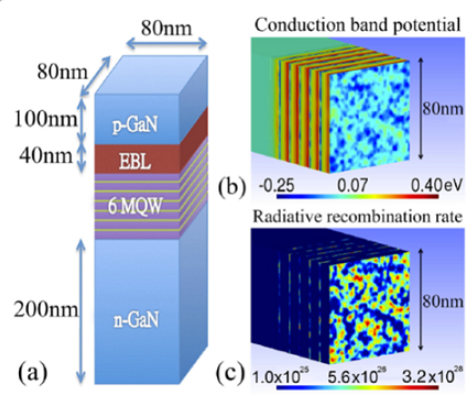 |
|
Fig. 2. (a) The simulated structure for modeling the carrier transport, which includes 6 QWs and one AlGaN electron blocking layer (EBL). (b) The calculated conduction band potential at 3.1 V. (c) The radiative recombination rate at a forward bias of 3.1 V. The unit is (1/cm3 s). |
Vertically-Aligned
Polymer-Stabilized Liquid Crystal (VA-PSLC) with
a Curing Voltage
Professor Wing-Kit Choi
Graduate Institute of Photonics and
Optoelectronics, National Taiwan University
We have recently been developing a new Liquid Crystal (LC) mode known as “Vertically-Aligned Polymer-Stabilized Liquid Crystal (VA-PSLC) with a curing voltage”. In this LC mode, a curing voltage was found to help reduce the otherwise strong scattering effect of a VA-PSLC. This LC mode was placed inside a Fabry-Perot cavity (coated with dielectric mirrors) to achieve a fast-response wavelength-tunable filter. Wavelength tuning range was found to decrease as curing voltage increased, which is consistent with what we expected since molecules had a larger pretilt angle when the curing voltage was higher. Shortening of response time (> 10X) was found as polymer concentration increased since the polymer effect helped improve the response speed. These filters can have potential in wavelength tuning applications such as Wavelength Division Multiplexing (WDM) in telecommunication systems where high speed is desirable. This new LC mode can also find applications where both fast response time and phase-only modulation are desirable (such as LCoS, beam steering, LC lens etc.)
|
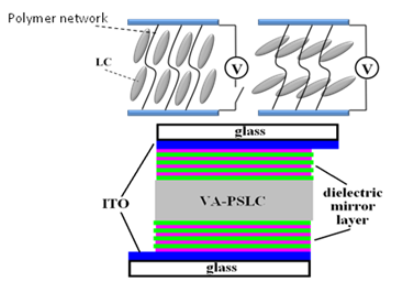 |
|
Fig. 1. (Top) VA-PSLC with pretilt angle generated by a curing voltage. (Bottom) Structure of a VA-PSLC Fabry-Perot filter. |
|
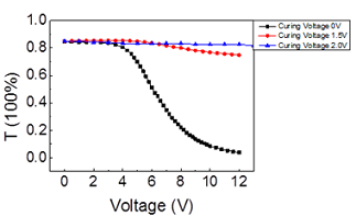 |
|
Fig. 2. Much reduced scattering (T↑) by adding a curing voltage. |
|
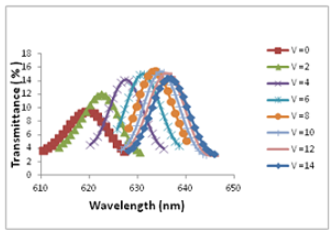 |
|
Fig. 3. Shift of resonance peaks by applying voltage to a Fabry-Perot filter filled with VA-PSLC with a curing voltage. |
|
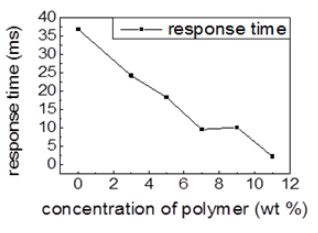 |
|
Fig. 4. Shortening of response time as polymer concentration increases. |
Ref:
Wing-Kit Choi and Yan-Min Li ,
“Vertically-Aligned Polymer-Stabilized Liquid
Crystals (VA-PSLC) with a Curing Voltage for
fast-response wavelength tuning Applications”,
accepted and to be published in Molecular
Crystals and Liquid Crystals in March/April,
2015
Investigation of Junction Thermal Characteristics of Light-Emitting Transistors
Professor Chao-Hsin Wu
Graduate Institute of Photonics and
Optoelectronics, National Taiwan University
We demonstrate the DC temperature-variation measurement including thermal-electric feedback coefficient to extract the junction temperature and thermal resistance of the light-emitting transistor (LET). The schematic of the device top view and cross section are shown (Fig. 1). The quantum-wells (QWs) embedded in the base region of the heterojunciton bipolar transistor (HBT) can enhance radiative recombination and carry out the energy by photons instead of phonons. Therefore, self-heating effect can be mitigated.
The thermal-electric feedback coefficient of the LET in this work is -2.07 mV/K under collector current of 2 mA (Fig. 2) and is larger than that (-1.66 mV/K) of the reference HBT. The thermal resistance of the LET is 993.3
oC/W at power consumption of 44.19 mW, while that of the reference HBT is 1027
oC/W at power consumption of 21 mW (Fig. 3). The large magnitude of the thermal-electric feedback coefficient of the LET can be explained by carrier dynamics mechanism in QWs such as temperature-dependent thermionic emission. By tuning the QW design of the LET, a more temperature-sensitive device can be achieved for future sensor application.
This work has been accepted by IEEE Trans. Electron Devices.
|
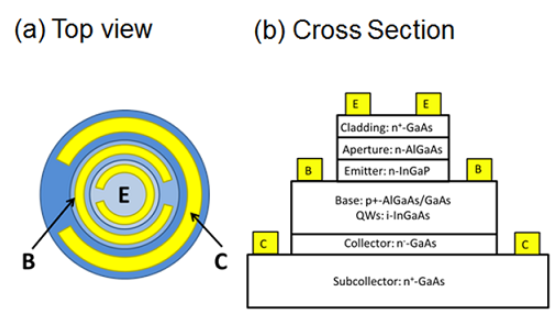 |
|
Fig. 1. (a) Schematic device top view layout and (b) cross section of the LET. The emitter area is 18 μm × 18 μm. |
|
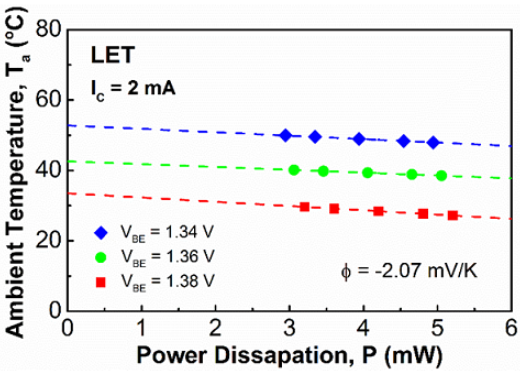 |
|
Fig. 2.
Ta
corresponding to several constant
VBE
values of
P. All curves are at
IC
= 2 mA. The dashed lines are linear fitting to the symbols, extended to cross the
P
= 0 axis. |
|
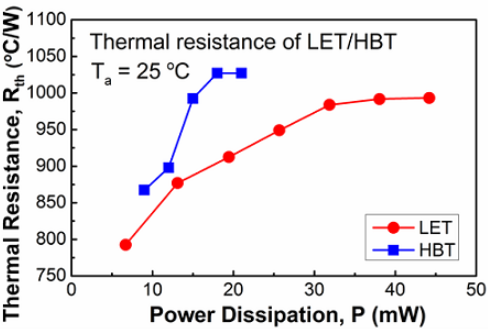 |
|
Fig. 3.
Rth under different power dissipation
P. The red circle points are the
Rth of the LET and the blue rectangular points are the
Rth of the HBT. |
|
|
|
 |
|
 |
|
| |
|
|
 |
|
 |
|
|
|